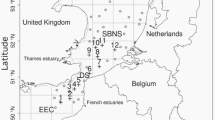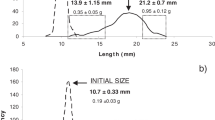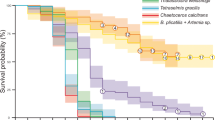Abstract
The utilization and fate of nitrogen in larvae of plaice (Pleuronectes platessa), blenny (Blennius pavo) and herring (Clupea harengus), from the stage of first-feeding to metamorphosis, was examined under laboratory conditions. Rates of ammonia excretion, primary amine defaecation, and growth in terms of protein-nitrogen were monitored throughout larval life. Data were used to calculate daily ration, the coefficient of nitrogen utilization (absorption efficiency), and gross and net growth efficiencies. The developmental pattern of nitrogen balance was similar for plaice and blenny larvae. These species showed increasing growth efficiency (k1: 55 to 80%) with decreasing weight-specific waste nitrogen losses with age. Absorption efficiencies. were high (83 to 98%) in plaice and blenny larvae, and tended to increase with development in the former species. Ration relative to body weight decreased with growth in both species. Herring larval development, although at a slower rate than blenny and plaice, appeared normal up to 33 d, after which high mortality occurred. Absorption efficiency in this species tended to decline (83 to 43%) with age, until metabolic costs exceeded the absorbed ration and growth ceased. Artemia sp. nauplii proved a suitable food source for the rearing of plaice and blenny larvae, but this diet may have long-term toxicity or deficiency effects on herring. Availability and density of food affected nitrogen balance in the larvae of all three species. Feeding stimulated the output of wastes in excretion and defaecation by a factor of up to ten times the 12-h non-feeding basal rates. Waste nitrogen output reached a peak some 2 to 3 h after commencement of feeding and returned slowly to the baseline in 5 to 10 h after cessation of feeding. There was an asymptotic increase in ration, ammonia output and growth of larvae as prey density increased. Ration saturated at a higher prey density (>4 prey ml-1) than either growth or excretion rate (1 prey ml-1). Thus the efficiency with which food is absorbed and utilized for growth must eventually decline in response to high prey density. The idea that larval fish are adapted to maximize ingestion and growth rate, rather than optimize growth efficiency and thus to respond to prey occurring in either low density or in occasional patches, is supported by these results.
Similar content being viewed by others
Literature cited
Benijts, F., E. van Voorden and P. Sorgeloos: Changes in the biochemical composition of the early larval stages of the brine shrimp Artemia salina. 10th Eur. Symp. Mar. Biol. Belgium 1, 1–9 (1975)
Beyer, J. E. and P. Munk Christensen: Food consumption by larval fish. Int. Counc. Explor. Sea Coop. Res. 28, 1–15 (1980)
Birkett, L.: The nitrogen balance in plaice, sole and perch. J. exp. Biol. 50, 375–386 (1969)
Boehlert, G. W. and M. Yoklavich: Carbon assimilation as a function of ingestion rate in larval Pacific herring, Clupea harengus pallasi. J. exp. mar. Biol. Ecol. 79, 251–262 (1984)
Brett, J. R. and C. A. Zala. Daily pattern of nitrogen excretion and oxygen consumption of sockeye salmon (Oncorhynchus nerka) under controlled conditions. J. Fish. Res. Bd Can. 32, 2479–2486 (1975)
Buckley, L. and D. W. Dillman: Nitrogen utilization by larval summer flounder Paralichthys dentatus. J. exp. mar. Biol. Ecol. 59, 243–256 (1982)
Checkley, D. M.: Relation of growth to ingestion for larvae of Atlantic herring Clupea harengus and other fish. Mar. Ecol. Prog. Ser. 18, 215–224 (1984)
Davenport, J., A. Lönning and B. Kjörsvik: Ammonia output by eggs and larvae of the lumpsucker, Cyclopterus lumpus, the cod, Gadus morhua and the plaice Pleuronectes platessa. J. mar. biol. Ass. U.K. 63, 713–723 (1983)
Ehrlich, K. F.: A preliminary study of the chemical composition of sea-caught larval herring and plaice. Comp. Biochem. Physiol. 51B, 25–28 (1975)
Ehrlich, K. F., J. Blaxter and R. Pemberton: Morphological and histological changes during the growth and starvation of herring and plaice larvae. Mar. Biol. 35, 105–118 (1976)
Gerking, S. D.: Influence of rate of feeding on body composition and protein metabolism of bluegill sunfish. Physiol. Zool. 28, 267–282 (1955)
Gerking, S. D.: Influence of rate of feeding and body weight on protein metabolism in bluegill sunfish. Physiol. Zool. 44, 9–19 (1971)
Gerking, S. D. (ed.): Ecology of freshwater fish production, 520 pp. Oxford: Blackwell Scientific Publication 1978
Grasshoff, K., M. Ehrhardt and K. Kremling: Methods of seawater analysis, 419 pp. Weinheim: Verlag Chemie 1983
Hansen, P.-D., H. von Westernhagen and H. Rosenthal: Chlorinated hydrocarbons and hatching success in Baltic herring spring spawners. Mar. envir. Res. 15, 59–76 (1985)
Houde, E. D.: Critical food levels for growth and survival of laboratory-reared larvae of 3 species of subtropical marine fishes. Bull. mar. Sci. 28, 395–411 (1978)
Houde, E. D. and R. C. Schekter. Feeding by marine fish larvae: developmental and functional responses. Envir. Biol. Fish. 5, 315–334 (1980)
Hunter, J. R. and C. A. Kimbrell: Early life history of Pacific mackerel Scomber japonicus. Fish. Bull., U.S. 78, 89–101 (1980)
Jobling, M.: Some effects of temperature, feeding and body weight on nitrogenous excretion in young plaice Pleuronectes platessa. J. Fish Biol. 18, 87–96 (1981)
Kaushik, S. J. and K. Dabroswki. Nitrogen and energy utilization in juvenile carp (Cyprinus carpio) fed casein, amino acids or a protein-free diet. Reprod. Nutr. Develop. 23, 741–754 (1983)
Laurence, G. C.: A bioenergetic model for the analysis of feeding and survival of winter flounder larvae during the period from hatching to metamorphosis. Fish. Bull., U.S. 75, 529–546 (1977)
Lowry, O. H., N. J. Rosebrough, A. L. Farr and R. J. Randall: Protein measurement with the Folin phenol reagent. J. Biol. Chem. 193, 265–275 (1951)
North, B. B.: Primary amines in California coastal waters: utilization by phytoplankton. Limnol. Oceanog. 20, 20–22 (1975)
Pandian, T. J.: Intake, digestion, absorption and conversion of food in the fishes Megalops cyprinoides and Ophiocephalus striatus. Mar. Biol. 1, 16–32 (1967)
Riley, J. D.: Marine fish culture in Britain. VII, Plaice (Pleuronectes platessa) post larval feeding on Artemia salina nauplii and the effects of varying feeding levels. J. Cons. perm. int. Explor. Mer 30, 204–221 (1966)
Rosenthal, H.: Verdauungsgeschwindigkeit, Nahrungsbedarf und Nahrungswahl bei den Larven des Herings, Clupea harengus. Ber. dtsch. wiss. Kommn Meeresforsch. 20, 60–69 (1969)
Rosenthal, H. and G. Hempel: Experimental studies in feeding and food requirements of herring larvae (Clupea harengus). In: Marine food chains, pp 344–364. Ed. by J. H. Steele. Edinburgh: Oliver and Boyd 1970
Rosenthal, H. and G. Hempel: Experimental estimates of minimum food density for herring larvae. Cons. int. Explor. Mer 160, 125–127 (1971)
Savitz, J.: Nitrogen excretion and protein consumption of the bluegill sunfish (Lepomis macrochirus). J. Fish. Res. Bd Can. 28, 449 (1971)
Solórzano, L.: Determination of ammonia in natural waters by the phenolhypochlorite method. Limnol. Oceanogr. 14, 779–801 (1969)
Stephien, W. P.: Feeding of laboratory-reared larvae of the sea bream Archosargus rhomboidalis (Sparidae) Mar. Biol. 38, 1–16 (1976)
Theilacker, G. H. and K. Dorsey: Larval fish diversity. In: Workshop on the effects of environmental variation on the survival of larval pelagic fishes. Intergovernmental oceanogr. Commun. Rep. UNESCO Paris 28, 105–142 (1980)
Wallace, J. C.: Observations on the relationship between the food consumption and metabolic rate of Blennius pholis. Comp. Biochem. Physiol. 45A, 293–306 (1973)
Werner, R. G. and J. H. Blaxter: Growth and survival of larval herring (Clupea harengus) in relation to prey density. Can. J. Fish. aquat. Sci. 37, 1063–1069 (1980)
Westernhagen, H. von: Erbrütung der Eier von Dorsch (Gadus morhua), Flunder (Pleuronectes flesus) und Scholle (Pleuronectes platessa) unter kombinierten Temperatur-und Salzgehalts-bedingungen. Helgoländer wiss. Meeresunters. 21, 21–102 (1970)
Westernhagen, H. von: Observations on the reproductive and larval biology of Blennius pavo. Helgoländer wiss. Meeresunters. 36, 323–335 (1983)
Westernhagen, H. von and H. Rosenthal: On condition factor measurements in Pacific herring larvae. Helgoländer wiss. Meeresunters. 34, 257–262 (1981)
Wyatt, T.: Some effects of food density on the growth and behavior of plaice larvae. Mar. Biol. 14, 210–216 (1972)
Author information
Authors and Affiliations
Additional information
Communicated by O. Kinne, Oldendorf/Luhe
Rights and permissions
About this article
Cite this article
Klumpp, D.W., von Westernhagen, H. Nitrogen balance in marine fish larvae: influence of developmental stage and prey density. Mar. Biol. 93, 189–199 (1986). https://doi.org/10.1007/BF00508256
Accepted:
Issue Date:
DOI: https://doi.org/10.1007/BF00508256




